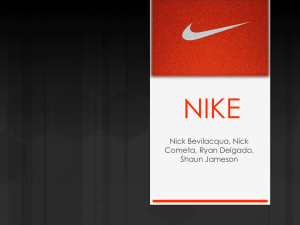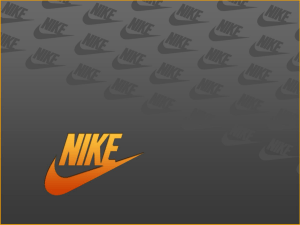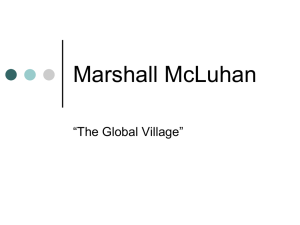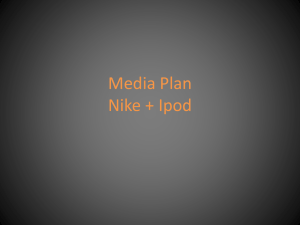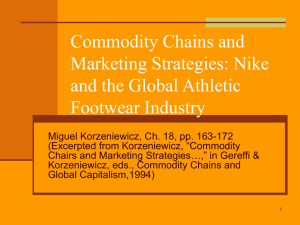Nike PP_Final
advertisement
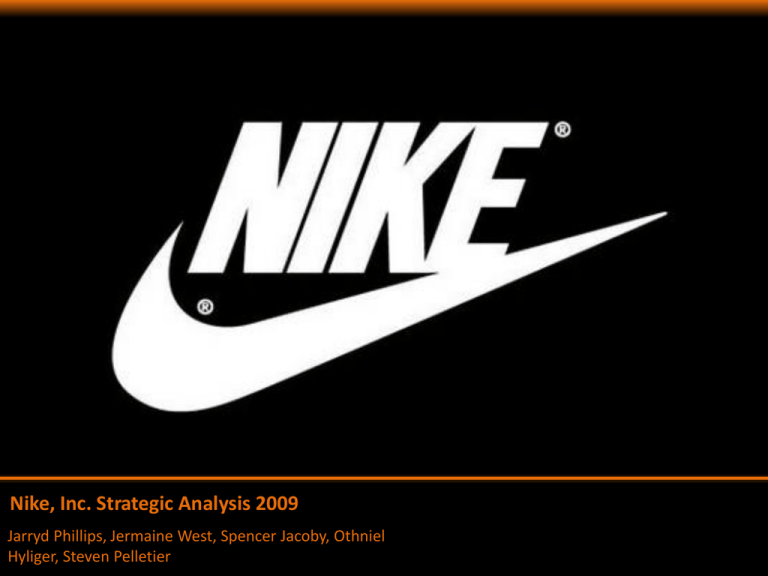
Nike, Inc. Strategic Analysis 2009 Jarryd Phillips, Jermaine West, Spencer Jacoby, Othniel Hyliger, Steven Pelletier HISTORY MAJOR MILESTONES CURRENT VISION & MISSION STATEMENTS PROPOSED VISION & MISSION STATEMENTS EXTERNAL ASSESSMENT POSITIONING MAP CPM MATRIX OPPORTUNITIES & THREATS EFE MATRIX INTERNAL ASSESSMENT ORGANIZATIONAL CHART 2009 INCOME STATEMENT 2009 BALANCE SHEET CURRENT FINANCIAL RATIOS FINANCIAL TRENDS STRENGTH & WEAKNESSES IFE MATRIX STRATEGIC ASSESSMENT SWOT MATRIX SPACE MATRIX GRAND STRATEGY MATRIX BCG MATRIX IE MATRIX MATRIX ANALYSIS QSPM RECOMMENDATIONS OBJECTIVES STRATEGIC IMPLEMENTATION PROJECTED INCOME STATEMENT PROJECTED BALANCE SHEET PROJECTED FINANCIAL RATIOS EVALUATION BALANCED SCORECARD SOURCES QUESTIONS 2 3 • • • • • • • • • • • • 1970- The Swoosh first appears on a football/soccer cleat called the Nike. 1978- Tennis "bad boy" John McEnroe is signed by Nike to an endorsement contract. 1989- Nike enters the European football market 1994 +2003- Nike wins Advertiser of the Year at the Cannes Advertising Festival. 1996- Nike signs Tiger Woods 1999- Bill Bowerman, co-founder of Nike, dies on Dec. 24 at age 88. 2002- Nike purchases Hurley International 2003- Nike acquires once-bankrupt rival Converse for $305 million 2004- Phil Knight steps down as CEO and President of Nike, but continues as chairman 2005- Nike Signs Tennis Pro Rafael Nadal. 2006- Nike and Apple release the Nike+iPod sports kit 2008- Nike sells its Nike Bauer hockey equipment division & purchases Umbro. 4 "To bring inspiration and innovation to every athlete in the world" If you have a body, you are an athlete. Nike co-founder Bill Bowerman 5 To lead in corporate citizenship through proactive programs that reflect caring for the world family of Nike, our teammates, our consumers, and those who provide services to Nike. 6 To equip every athlete with products that combine performance, quality, and fashion. 7 At Nike, we desire to deliver superior products to customers and athletes that are both safe and dependable (1, 2 and 6). Our well trained employees and experienced executives will ensure a competitive advantage for our markets, growth for the company, and profits for our shareholders (5). Our commitment to social responsibility and the communities in which we operate will ensure business relationships and alliances for the future and a perception of concern with our stakeholders (6, 8). We will continue to utilize innovation and technology to provide our employees with the best possible work environment while adapting to the many changes in the global market (3, 4, 7, and 9). 1. Customers 2. Products or services 3. Markets 4. Technology. 5. Concern for survival, growth, and profitability 6. Philosophy 7. Self-concept 8. Concern for public image 9. Concern for employees 8 9 High Performance Low Price High Price Low Performance 10 NIKE Critical Success factors Advertising Product Quality Price Competitiveness Management Financial Position Customer Loyalty Global Expansion Market Share Brand Endorsement Deals Portfolio Diversification Product Placement Research & Development Totals Weights Rating 0.0 to 1.0 1 to 4 0.10 0.08 0.08 0.06 0.08 0.05 0.05 0.08 0.09 0.10 0.08 0.09 0.06 1.00 3 4 2 3 4 3 3 4 4 4 3 3 3 Weighted Score ADIDAS Rating Weighted Score 1 to 4 0.30 0.32 0.16 0.18 0.32 0.15 0.15 0.32 0.36 0.40 0.24 0.27 0.18 3.35 4 3 3 4 3 2 4 2 3 3 4 2 4 PUMA Rating Weighted Score 1 to 4 0.40 0.24 0.24 0.24 0.24 0.10 0.20 0.16 0.27 0.30 0.32 0.18 0.24 3.13 3 2 1 2 1 1 2 1 1 3 2 1 1 0.20 0.16 0.08 0.12 0.08 0.05 0.10 0.08 0.09 0.30 0.16 0.09 0.06 1.57 11 1. Creating sportswear that would incorporate recycled materials from their own production lines and other places. 2. Promotion as a fashionable wear, not just sportswear. 3. Growing segment of the female athletes. 4. International expansion into emerging markets – e.g.. India 5. Additional marketing of existing products to appeal to new demographic groups. 6. Develop new alliances with companies that are respected regarding social responsibility. 7. Brand reorganization by market regions 12 1. High competitive industry 2. Failure to respond to market trends in timely manner could greatly affect financial position. 3. Production of counterfeit goods, and generic products. 4. Negative public perception created by environmental, child labor, contracted manufacturing issues, and sponsored athletes. 5. International currency changes could decrease profits. 6. Federal Trade regulations in dealing with foreign manufactures. 13 External Opportunities 1. Creating sportswear that would incorporate recycled materials from their own production lines and other places. 2. Promotion as a fashionable wear, not just sportswear. 3. Growing segment of the female athletes. 4. International expansion into emerging markets – e.g. India 5. Additional marketing of existing products to appeal to new demographic groups. 6. Develop new alliances with companies that are respected regarding social responsibility. 7. Brand reorganization by market regions External Threats 1. High competitive industry 2. Failure to respond to market trends in timely manner could greatly affect financial position. 3. Production of counterfeit goods, and generic products. 4. Negative public perception created by environmental, child labor, contracted manufacturing issues, and sponsored athletes. 5. International currency changes could decrease profits. 6. Federal Trade regulations in dealing with foreign manufactures. Totals 0.05 0.06 0.08 0.12 3 2 3 4 0.15 0.12 0.24 0.48 0.07 2 0.14 0.06 0.07 1 2 0.06 0.14 0.14 4 0.56 0.09 0.06 4 2 0.36 0.12 0.09 0.06 3 2 0.27 0.12 0.05 2 0.27 1.00 3.03 14 15 Philip H. Knight Chairman of the Board Mark G. Parker CEO and President Gary M. Destefano Donald W. Blair President of Global Vice President and Operationsitle CFO Hans van Alebeek Vice President, Global operations & Technology David J. Ayre Ronald D. McCray Vice President Vice President Global Human Chief Administrative Resoursces officer Bernard F. Pliska Vice President Corporate Controller Trevor Edwards Vice John Slusher President Global Vice President Brand & Category Global Management Sports Marketing Charles D. Denson Lewis L. Bird III President Nike Brand President Affiliates Eric D. Sprunk Vice President Global Footwear 16 Year Ended May 31 (In millions, except per share data) 2009 2008 2007 Revenues $ 19,176.10 $ 18,627.0 $ 16,325.9 Cost of sales $ 10,571.70 $ 10,239.6 $ 9,165.4 Gross margin $ 8,604.40 $ 8,387.4 $ 7,160.5 Selling and administrative expense $ 6,149.60 $ 5,953.7 $ 5,028.7 Restructuring charges (Note 16) $ 195.00 $ - $ - Goodwill impairment (Note 4) $ 199.30 $ - $ - Intangible and other asset impairment (Note 4) $ 202.00 $ - $ - Interest income, net (Notes 1, 7 and 8) $ (9.50) $ (77.1) $ (67.2) Other (income) expense, net (Notes 17 and 18) $ (88.50) $ 7.9 $ (0.9) Income before income taxes $ 1,956.50 $ 2,502.9 $ 2,199.9 Income taxes (Note 9) $ 469.80 $ 619.5 $ 708.4 Net income $ 1,486.70 $ 1,883.4 $ 1,491.5 Basic earnings per common share (Note 12) $ 3.07 $ 3.80 $ 2.96 Diluted earnings per common share (Note 12) $ 3.03 $ 3.74 $ 2.93 Dividends declared per common share $ 0.98 $ 0.875 $ 0.71 17 May 31, 2009 (In millions) 2008 ASSETS Current assets: Cash and equivalents Short-term investments Accounts receivable, net (Note 1) Inventories (Notes 1 and 2) Deferred income taxes (Note 9) Prepaid expenses and other current assets Total current assets Property, plant and equipment, net (Note 3) Identifiable intangible assets, net (Note 4) Goodwill (Note 4) Deferred income taxes and other assets (Notes 9 and 18) Total assets LIABILITIES AND SHAREHOLDERS’ EQUITY Current liabilities: Current portion of long-term debt (Note 8) Notes payable (Note 7) Accounts payable (Note 7) Accrued liabilities (Notes 5 and 18) Income taxes payable (Note 9) Total current liabilities Long-term debt (Note 8) Deferred income taxes and other liabilities (Note 9) Commitments and contingencies (Notes 15 and 18) Redeemable Preferred Stock (Note 10) Shareholders’ equity: Common stock at stated value (Note 11): Class A convertible — 95.3 and 96.8 shares outstanding Class B— 390.2 and 394.3 shares outstanding Capital in excess of stated value Accumulated other comprehensive income (Note 14) Retained earnings Total shareholders’ equity $ 2,291.10 $ 1,164.00 $ 2,883.90 $ 2,357.00 $ 272.40 $ 765.60 $ 9,734.00 $ 1,957.70 $ 467.40 $ 193.50 $ 897.00 $ 13,249.60 $ 2,133.90 $ 642.20 $ 2,795.30 $ 2,438.40 $ 227.20 $ 602.30 $ 8,839.30 $ 1,891.10 $ 743.10 $ 448.80 $ 520.40 $ 12,442.70 $ $ $ $ $ $ $ $ $ $ 32.00 342.90 1,031.90 1,783.90 86.30 3,277.00 437.20 842.00 0.3 $ $ $ $ $ $ $ $ $ $ 6.30 177.70 1,287.60 1,761.90 88.00 3,321.50 441.10 854.50 0.3 $ $ $ $ $ 0.1 2.7 2,871.40 367.50 5,451.40 8693.1 $ $ $ $ $ 0.1 2.7 2,497.80 251.40 18 5,073.30 7825.3 Liquidity Ratios Current Quick Leverage Ratios Debt to total assets Debt to equity Long-term debt to equity Times-interest-earned ratio Activity Ratios Fixed Assets Turnover Total Assets Turnover Inventory Turnover Profitability Ratios 2.97 2.25 0.06 0.09 0.05 61.06 9.8 1.45 8.14 Gross profit margin Operating profit margin Net profit margin Return on assets Return on equity 0.45 0.13 0.08 0.11 0.17 Price-earnings ratio EPS 18.83 3.03 Growth Ratios Sales Growth% Net Income Growth% Earnings per share Growth% 3 Years 0.28226 0.06803 -0.4261 Dividends per share Growth% -0.1695 19 Date Sales EBIT DEPRECIATION TOTAL NET INCOME LONG TERM DEBT May-09 19.18 Bill 1.96 Bill 347.00 Mill 1.49 Bill 437.20 Mill May-08 18.63 Bill 2.50 Bill 312.80 Mill 1.88 Bill 441.10 Mill May-07 16.33 Bill 2.20 Bill 279.60 Mill 1.49 Bill 409.90 Mill May-06 14.95 Bill 2.14 Bill 291.80 Mill 1.39 Bill 410.70 Mill May-05 13.74 Bill 1.86 Bill 266.50 Mill 1.21 Bill 687.30 Mill 20 1. Recognized brand name – ‘Swoosh’ is ubiquitous 2. Strong in research and development – innovative product development 3. Strong marketing campaign - sponsors top athletes. Marketing practices enables them to expand the athletic market. 4. Diverse portfolio 5. Successful advertising campaigns. 6. Customer loyalty 7. Strong financial position 8. Strong international presence 21 1. Products are highly priced 2. Revenues are still mostly dependent upon footwear sales 3. History for violations of minimum wages, child labor and over times in its manufacturing countries. 4. Little control over quality of products from 3rd party contractors 5. Anti-globalization groups 6. Price sensitivity of products 22 Internal Strengths Recognized brand name – Swoosh is ubiquitous Strong in research and development – innovative product development Strong marketing campaign - sponsors top athletes. Marketing practices enables them to expand the athletic market A very professionally competitive company Diverse portfolio Successful advertising campaigns Customer loyalty Strong financial position Strong international presence Internal Weaknesses Products are highly priced Revenues are still mostly dependent upon footwear sales History for violations of minimum wages, child labor and over times in its manufacturing countries. Little control over quality of products from 3rd party contractors Anti-globalization groups Price sensitivity of products Totals 0.10 4 0.40 0.07 3 0.21 0.09 4 0.36 0.08 0.08 0.09 0.06 0.09 0.10 3 3 4 3 4 4 0.24 0.24 0.36 0.18 0.36 0.4 0.06 2 0.12 0.05 2 0.10 0.06 2 0.12 0.05 0.04 0.06 1.00 1 2 2 0.05 0.08 0.12 3.10 23 24 SO Strategy - S1, O2, O3: The swoosh is so well known that recycled materials and fashionable lines of clothing would definitely create a whole new dimension for Nike. - S3, O3, O4: With some of the most recognizable and followed athletes globally, expanding into places like India and forming alliances with different kinds of sports leagues will be a viable strategy to expand. - S5, O6, O7: Use the company`s successful competitiveness and alliances to reorganizing the brand name and appeal to new/ different demographic groups. WO Strategy - W1, W2, O1, O2:Creating sportswear and even fashionable wear from recycled materials, would be an opportunity to sell products at a lower cost. - W4, O4: Use 3rd party contractors to manufacture cheap/ lower cost products in order to appeal to the group of consumers who end up buying generic products, because official merchandise is too expensive. ST Strategy - S3, S9, T1, T2: Nike is well known for some of the athletes that it endorses, as well as its international presence, which will help maintain and attract customers even if there are high prices and challenging economic times, as long as it remains at the forefront of market trends. - S6, S7, T3: The quality of material throughout Nike`s diversified portfolio, may be able to help combat counterfeit goods and generic products. Especially now that many consumers associate cost with quality. WT Strategy - W3, W5, T4, T5: Due to Nike`s history of low labor wages to the thousands of factory workers, a recession may spell the end of many jobs and the production of many more important products. Improving the working conditions and pay of its factory workers is an ideal strategy to prevent such circumstances. 25 Financial Strength rating is 1 (worst) to 6 (best) 1 Liquidity 2 Leverage 3 Working capital 4 Return on assets 5 Return on equity 6 Price per earnings 7 Earnings per share Industry Strength rating is 1 (worst) to 6 (best) 1 Profit potential 2 Extent Leveraged 3 Economies of scale 4 Growth potential 5 Financial stability 6 Resource utilization 7 Diverse Portfolio Environmental Stability rating is -1 (best) to -6 (worst) 1 Price range of competing products 2 Competitive pressure 3 Ease of exit from market 4 Successful and recognized advertising 5 Endorsement agreements 6 Price elasticity of demand 7 Risk involved in business Competitive advantage rating is -1 (best) to -6 (worst) 1 Market share 2 Global presence 3 Strong investor reputation 4 Technological innovation 5 Product life cycle 6 Customer loyalty 7 Control over suppliers and distributors FS Total IS Total ES Total CS total Ratings 6.0 6.0 6.0 4.0 4.0 6.0 5.0 37.0 6.0 5.0 5.0 5.0 6.0 5.0 5.0 37.0 -2.0 -2.0 -1.0 -1.0 -1.0 -1.0 -1.0 -9.0 -1.0 -1.0 -1.0 -1.0 -2.0 -1.0 -3.0 -10.0 ES average CA average IS average FS average X Coordinate Y Coordinate Strategy ->>>> -1.29 -1.43 5.29 5.29 3.86 4.00 Aggressive 26 Rapid Market Growth Quadrant II Quadrant I Weak Competitive Market Strong Competitive Market Quadrant III o o o o o o o Market Development Market Penetration Product Development Forward Integration Backward Integration Horizontal Integration Related Diversification Quadrant IV Slow Market Growth 27 High 1.0 0.9 0.8 0.7 0.6 0.5 0.4 0.3 0.2 0.1 0 Low +25 +20 II +15 Stars +5 (3) 17% I Question Marks (4) 11% (1) 35% IGR 0 (2) 37% -5 -15 Cash Cow Dogs III IV -20 -25 Low Divisions Revenue % Revenue Profits % Profits RMSP IG Rate% (1) U.S. 6,542.9 39% 837.2 35% 1 1.20% (2) AMEA 5,512.2 33% 877.1 37% 1 -2.20% (3) Asia Pacific 3,322.0 20% 394.6 17% 1 2.70% (4) Americas 1,284.7 8% 263.6 11% 1 1.20% Total 16,661.8 100% 2,372.5 100% 28 High 3-4 E F E Medium 2-2.99 Low 1-1.99 Strong 3-4 Average 2-2.99 Weak 1-1.99 IFE 29 Alternative Strategies Forward Integration Backward Integration Horizontal Integration Market Penetration Market Development Product Development Related Diversification Unrelated Diversification Horizontal Diversification Joint Venture Retrenchment Divestiture Liquidation IE x x x x x x SPACE x x x x x x x x GRAND x x x x x x x BCG x x x x x x Count 4 4 4 4 4 4 2 1 x x x 1 1 1 30 Market Expansion Key factors External Create products from recycled materials Promotion as a fashionable wear, not just sportswear. Growing segment of the female athletes International expansion into emerging markets - India Add. marketing of existing prod - appeal to new groups New alliances with co. respected for social responsibility Brand reorganization by market regions High competitive industry Failure to respond to market trends in timely manner Negative public perception Federal Trade regulations with foreign manufactures International currency changes could decrease profits Production of counterfeit goods, and generic products total should be 1.0 Internal Recognized brand name – Swoosh is ubiquitous Strong in research and development/innovation Strong marketing campaign/sponsors top athletes Diverse portfolio Successful advertising campaigns Customer loyalty Strong financial position Strong international presence Products are highly priced Revenues still mostly dependent upon footwear sales Violations for wages and child labor in manuf. countries Little control over quality of prod. from 3rd party contract. Anti-globalization groups Price sensitivity of products total should be 1.0 Weight AS TAS 1 to 4 0.1 0.07 0.08 0.12 0.1 0.06 0.06 0.08 0.06 0.06 0.08 0.07 0.06 3 3 4 3 3 4 4 4 2 3 Prod/Recycle/Materials AS TAS 1 to 4 0.3 0.21 0.48 0.3 0.18 0.24 0.32 0.32 0.14 0.18 2 1 2 2 2 1 3 3 4 2 Add. Sports Accessories AS TAS 1 to 4 0.2 0.07 0.24 0.2 0.12 0.06 0.24 0.32 0.32 0.12 4 2 1 4 1 2 2 2 3 1 0.4 0.14 0.12 0.4 0.06 0.12 0.16 0.16 0.21 0.06 1 1 to 4 0.1 0.09 0.08 0.09 0.07 0.07 0.08 0.08 0.06 0.05 0.06 0.06 0.05 0.06 4 4 2 1 1 3 2 4 1 3 2 3 1 to 4 0.4 0.36 0.16 0.09 0.07 0.21 0.16 0.32 0.06 0.15 0.12 0.18 3 2 1 3 2 2 3 3 2 2 3 2 1 to 4 0.3 0.18 0.08 0.27 0.14 0.14 0.24 0.24 0.12 0.1 0.18 0.12 1 2 3 3 2 3 1 4 1 3 1 1 1 0.2 0.27 0.24 0.18 0.21 0.07 0.32 0.08 0.18 0.05 0.06 0.06 0 4.95 4 31 3.75 Open a new Nike Super store in each of India’s largest cities: Mumbai, Delhi, and Bangalore at $5 million per store. Sign an endorsement bat sponsorship deal with Sachin Tendulkar, India’s biggest cricket star to a multi-year contract. The terms include apparel, footwear, and his own name brand. The deal is worth $30 million over 3 years. Invest $500 million in India that will increase revenue by 4.5% through product development, market development, and market penetration in the next 3 years. Invest $235 million in R&D and manufacturing contracts over the next 3 years. Invest $220 million on marketing and advertisement over the next 3 years. 32 • To continue being the world leader in sports equipment and apparel. • To complete brand reorganization within market regions that will lower cost of sales. • To create sportswear that would incorporate recycled material. • To develop new alliances with companies who are well respected regarding social responsibility. • To invest in additional marketing of existing products that will appeal to new demographic groups. • To promote products as fashion wear, not just sportswear. 33 34 Year Ended May 31 2009 Projected 2010 (In millions, except per share data) Revenues $ 19,176.10 $ 19,463.74 Forecasted 1.5% revenue increase. Cost of sales $ 10,571.70 $ 10,730.28 1.5% increase. Gross margin $ $ 8,733.47 8,604.40 Selling and administrative expense $ 6,149.60 $ 6,351.95 Restructuring charges (Note 16) $ 195.00 $ Goodwill impairment (Note 4) $ 199.30 $ Intangible and other asset impairment (Note 4) $ 202.00 $ Interest income, net (Notes 1, 7 and 8) $ (9.50) $ (9.50) Other (income) expense, net (Notes 17 and 18) $ (88.50) $ (88.50) Income before income taxes $ 1,956.50 3.3% increase from previous year. 50.00 - $ 2,429.52 Income taxes (Note 9) $ 469.80 $ 583.08 Net income $ 1,486.70 Basic earnings per common share (Note 12) $ 3.07 $ 3.20 Diluted earnings per common share (Note 12) $ 3.03 $ 3.16 Dividends declared per common share $ 0.98 $ 1.00 Based on 24% from 2009 $ 1,846.43 35 Year Ended May 31, 2009 Projected 2010 ASSETS Current assets: Cash and equivalents Short-term investments Accounts receivable, net (Note 1) $ 2,291.10 $ 1,164.00 $ 2,883.90 $ 2,163.80 $ 1,164.00 $ 2,976.18 Minus $161.67 in investment. Inventories (Notes 1 and 2) Deferred income taxes (Note 9) Prepaid expenses and other current assets Total current assets $ 2,357.00 $ 272.40 $ 765.60 $ 9,734.00 $ 2,628.00 $ 272.40 $ 900.00 $ 10,104.38 Influenced by the cricket line Property, plant and equipment, net (Note 3) Identifiable intangible assets, net (Note 4) Goodwill (Note 4) Deferred income taxes and other assets (Notes 9 and 18) Total assets LIABILITIES AND SHAREHOLDERS’ EQUITY Current liabilities: Current portion of long-term debt (Note 8) Notes payable (Note 7) Accounts payable (Note 7) Accrued liabilities (Notes 5 and 18) Income taxes payable (Note 9) Total current liabilities $ 1,957.70 $ 467.40 $ 193.50 $ 897.00 $ 13,249.60 $ 1,972.70 $ 467.40 $ 95.00 $ 977.56 $ 13,617.04 Plus $15 million for three new stores. $ 32.00 $ 342.90 $ 1,031.90 $ 1,783.90 $ 86.30 $ 3,277.00 $ 6.90 $ 375.00 $ 1,051.50 $ 1,783.90 $ 90.00 $ 3,307.30 Long-term debt (Note 8) Deferred income taxes and other liabilities (Note 9) Commitments and contingencies (Notes 15 and 18) Redeemable Preferred Stock (Note 10) Shareholders’ equity: Common stock at stated value (Note 11): Class A convertible — 95.3 and 96.8 shares outstanding Class B— 390.2 and 394.3 shares outstanding Capital in excess of stated value Accumulated other comprehensive income (Note 14) Retained earnings Total shareholders’ equity Total liabilities and shareholders’ equity $ $ $ $ 437.20 842.00 0.30 $ $ 405.20 872.71 $ 0.30 $ $ $ $ $ $ $ 0.10 2.70 2,871.40 367.50 5,451.40 8,693.10 13,249.60 $ $ $ $ $ $ $ 0.10 2.70 2,995.40 367.50 5,665.83 9,031.53 13,617.04 3.2% previous Less portion of $32.0 36 2009 Projected 2010 2.97 2.25 3.06 2.26 0.06 0.09 0.05 0.06 0.09 0.04 48.55 65.66 9.8 1.45 8.14 9.87 1.43 7.41 0.45 0.1 0.08 0.11 0.17 18.83 3.03 0.45 0.12 0.09 0.14 0.20 17.83 3.20 Growth Ratios Sales Growth% Net Income Growth% 3 Years 0.28226 0.06803 1 Year 1.50 24.20 Earnings per share Growth% -0.4261 4.23 Dividends per share Growth% -0.1695 2.04 Liquidity Ratios Current Quick Leverage Ratios Debt to total assets Debt to equity Long-term debt to equity Times-interest-earned ratio Activity Ratios Fixed Assets Turnover Total Assets Turnover Inventory Turnover Profitability Ratios Gross profit margin Operating profit margin Net profit margin Return on assets Return on equity Price-earnings ratio EPS 37 38 Area of Objectives Customers 1. Customer satisfaction 2. Customer Loyalty 3. Accessibility Managers/Employees 1. Improve working conditions 2. Improve employee training Measure Time Expectation Primary Responsibility Customer and online surveys Quarterly Managers/ Marketing Product and purchasing reviews. Memberships and number of returning and new customers. Open more stores in various countries. Quarterly Marketing Biannually- Annually Marketing Quarterly Quarterly CEO Human Resources Annually CEO Biannually CEO Biannually Regional Managers Quarterly CEO Quarterly CEO/ Marketing Annually Marketing Annually CFO Annually CFO Increase in productivity, employee surveys. Increase in productivity and overall operating efficiency Community/Social Responsibility 1. Business Ethics Endorse positive role model athlete`s. Increase promotion of sports and wellness. 2. Environmentally Friendly Recycle materials, improve reputation and customer perspective. 3. Community involvement Run local sports camps, community/ city events- increase customer awareness. Operations/ Processes Increase in sales and customer 1. Improve Brand Image recommendations. 2. Product Innovation Number of new stores, products and marketing 3. Market Penetration Number of stores and sales in new/ other countries Financial 1. Reduce Cost of production Decrease in production expenses. 2. Increase Revenue Increase in annual sales 39 • http://www.youtube.com/watch?v=4Uugz5Y7 u6M 40 • • • • • • • • • • • • • • • http://investors.nikeinc.com/Investors/Financial-Reports-and-Filings/Annual-Reports/default.aspx http://investors.nikeinc.com/Theme/Nike/files/doc_financials/AnnualReports/2009/docs/Nike_2009 _10-K.pdf http://investors.nikeinc.com/Theme/Nike/files/doc_financials/AnnualReports/2006/docs/10k.pdf http://investing.businessweek.com/research/stocks/financials/financials.asp?ticker=NKE:US&data set=incomeStatement&period=A&currency=native http://finance.yahoo.com/q/is?s=NKE+Income+Statement&annual http://www.nike.com/nikeos/p/nike/en_US/?&ref Datamonitor.com – UMFK library sites http://en.wikipedia.org/wiki/List_of_most_populous_cities_in_India www.yahoofinance.com https://materials.proxyvote.com/Approved/654106/20090724/AR_44240/HTML2/default.htm http://en.wikipedia.org/wiki/Nike_timeline http://nikeinc.com/pages/history-heritage http://investing.money.msn.com/investments/financial-statements?symbol=NKE http://www.nike.com/nikeos/p/nike/en_IN/store_locator Strategic Management Concepts and Cases 13th Edition. Fred R. David. 41 42


